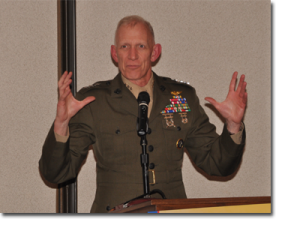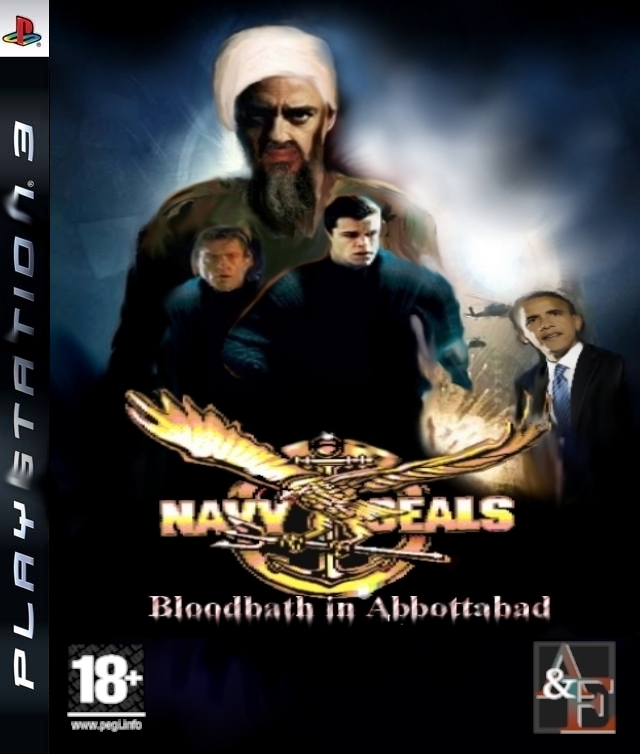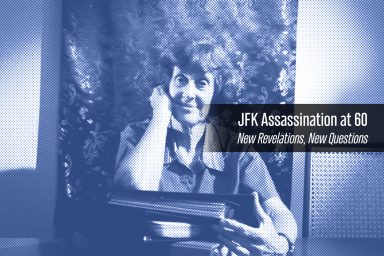Was The New Yorker’s gripping moment-by-moment account of the Abbottabad operation that killed Osama bin Laden great journalism—or the ultimate spin job?
“WE REALLY DIDN’T KNOW…WHAT WAS GOING ON”
About two-thirds of the article is a sort of scene-setter, a prologue to on-the-ground story we’ve all been waiting for. But when the big moment arrives, The New Yorker’s Schmidle instead punts:
Meanwhile, James, the squadron commander, had breached one wall, crossed a section of the yard covered with trellises, breached a second wall, and joined up with the SEALs from helo one, who were entering the ground floor of the house. What happened next is not precisely clear. “I can tell you that there was a time period of almost twenty to twenty-five minutes where we really didn’t know just exactly what was going on,” Panetta said later, on “PBS NewsHour.”
Until this moment, the operation had been monitored by dozens of defense, intelligence, and Administration officials watching the drone’s video feed. The SEALs were not wearing helmet cams, contrary to a widely cited report by CBS. None of them had any previous knowledge of the house’s floor plan, and they were further jostled by the awareness that they were possibly minutes away from ending the costliest manhunt in American history; as a result, some of their recollections—on which this account is based—may be imprecise and, thus, subject to dispute.
Schmidle claims that the SEALs’ “recollections—on which this account is based”—are subject to dispute. But as I’ve noted, the article is NOT based on their recollections, but on what some source claims to Schmidle were their recollections. Why the summary may be imprecise and thus subject to dispute after it has been filtered by a person controlling the scenario, must be asked. Perhaps this is why The New Yorker is not permitted to speak directly to the SEALs—because of what they could tell the magazine.
Now, killing the men who lived in the compound: First, the SEALs shot and killed the courier, who they say was armed, and his wife, who they say was not, when they emerged from the guesthouse. Then they killed the courier’s brother inside the main house, who they say was armed. Then they moved up the stairs:
..three SEALs marched up the stairs. Midway up, they saw bin Laden’s twenty-three-year-old son, Khalid, craning his neck around the corner. He then appeared at the top of the staircase with an AK-47. Khalid, who wore a white T-shirt with an overstretched neckline and had short hair and a clipped beard, fired down at the Americans. (The counterterrorism official claims that Khalid was unarmed, though still a threat worth taking seriously. “You have an adult male, late at night, in the dark, coming down the stairs at you in an Al Qaeda house—your assumption is that you’re encountering a hostile.”) At least two of the SEALs shot back and killed Khalid.
Ok, that’s pretty strange. First, Schmidle asserts that Khalid bin Laden was armed and fired with an AK-47. Then he quotes this counterterrorism official—who could in fact be Brennan—saying that Khalid was unarmed. Why does the New Yorker first run the “Khalid was armed” claim as a fact, and then include the official disclaimer? What’s really going on here, even from the New Yorker’s editorial standpoint?
Here’s another such instance: a dispute over where Osama was when they first saw him:
Three SEALs shuttled past Khalid’s body and blew open another metal cage, which obstructed the staircase leading to the third floor. Bounding up the unlit stairs, they scanned the railed landing. On the top stair, the lead SEAL swivelled right; with his night-vision goggles, he discerned that a tall, rangy man with a fist-length beard was peeking out from behind a bedroom door, ten feet away. The SEAL instantly sensed that it was Crankshaft [codename for Osama]. (The counterterrorism official asserts that the SEAL first saw bin Laden on the landing, and fired but missed.)
What’s the purpose of all this? How good is intelligence work when they can’t reconstruct whether the singular focus of the operation was first spotted peeking out from a doorway, or standing on the landing above them?
And then one of the most interesting passages, about the kill:
A second SEAL stepped into the room and trained the infrared laser of his M4 on bin Laden’s chest. The Al Qaeda chief, who was wearing a tan shalwar kameez and a prayer cap on his head, froze; he was unarmed. “There was never any question of detaining or capturing him—it wasn’t a split-second decision. No one wanted detainees,” the special-operations officer told me. (The Administration maintains that had bin Laden immediately surrendered he could have been taken alive.)
Uh-oh. So who is this Special Operations officer? He is directly disputing the administration’s claim on what surely matters greatly—what were President Obama’s intentions here? And did they always plan to just ignore them? That The New Yorker just drops this in with no further analysis or context is, simply put, shocking.
It seems almost as if Panetta, Obama, and the people in the story who most closely approximate actual representatives of the public in a functioning democracy, were basically cut off from observing what went down that day—or from influencing what transpired.
Consider this statement from Panetta, not included in the New Yorker piece:
“Once those teams went into the compound I can tell you that there was a time period of almost 20 or 25 minutes where we really didn’t know just exactly what was going on. And there were some very tense moments as we were waiting for information.
“We had some observation of the approach there, but we did not have direct flow of information as to the actual conduct of the operation itself as they were going through the compound.”
Panetta’s “lost 25 minutes” needs to be seen in the context of a man with civilian roots, notwithstanding two mid-60s years as a Lt. in military intel: Former Congressman, Clinton White House budget chief and Chief of Staff, credentials with civil rights and environment movements—a fellow with real distance from the true spook/military mojo.
Taken together, here’s what we have: President Obama did not know exactly what was going on. He did not decide that bin Laden should be shot. And he did not decide to dump his body in the ocean. The CIA and its Special Ops allies made all the decisions.
Then Brennan, the CIA’s man, put out the version that CIA wanted. (Keep in mind that, as noted earlier, CIA was really running the operation—with Special Ops under its direction).
What we’re looking at, folks, is the reality of democracy in America: A permanent entrenched covert establishment that marches to its own drummer or to drummers unknown. It’s exactly the kind of thing that never gets reported. Too scary. Too real. Better to dismiss this line of inquiry as too “conspiracy theory.”
If that sounds like hyperbole, let me add this rather significant consideration. It is the background of Nicholas Schmidle, the freelancer who wrote the New Yorker piece. It may give us insight into how he landed this extraordinary exclusive on this extraordinarily sensitive matter—information again, significantly, not shared by The New Yorker with its readers:
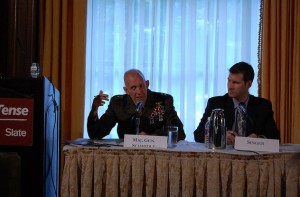 Schmidle’s father is Marine Lt. General Robert E. “Rooster” Schmidle Jr. General Schmidle served as Commanding Officer of Special Purpose Marine Air-Ground Task Force (Experimental)—that’s essentially Special Operations akin to Navy SEALs. In recent years, he was “assistant deputy commandant for Programs and Resources (Programs)”—where, among other things, he oversaw “irregular warfare.” (See various, including contract specs here on “Special Operations,” and picture caption here) In 2010, he moved into another piece of this, when Obama appointed him deputy commander, U.S. Cyber Command. Cumulatively, this makes the author’s father a very important man in precisely the sort of circles who care how the raid is publicly portrayed—and who would be quite intimate with some of the folks hunkering down with Obama in the Situation Room on the big day.
Schmidle’s father is Marine Lt. General Robert E. “Rooster” Schmidle Jr. General Schmidle served as Commanding Officer of Special Purpose Marine Air-Ground Task Force (Experimental)—that’s essentially Special Operations akin to Navy SEALs. In recent years, he was “assistant deputy commandant for Programs and Resources (Programs)”—where, among other things, he oversaw “irregular warfare.” (See various, including contract specs here on “Special Operations,” and picture caption here) In 2010, he moved into another piece of this, when Obama appointed him deputy commander, U.S. Cyber Command. Cumulatively, this makes the author’s father a very important man in precisely the sort of circles who care how the raid is publicly portrayed—and who would be quite intimate with some of the folks hunkering down with Obama in the Situation Room on the big day.
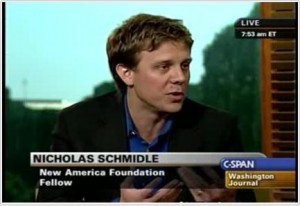 You can see a photo of Gen. Schmidle on a 2010 panel about “Warring Futures.” Event co-sponsors include Slate magazine and the New America Foundation, both of which, according to Nicholas Schmidle’s website, have also provided Schmidle’s son with an ongoing perch (with Slate giving him a platform for numerous articles from war zones and the foundation employing him as a Fellow.) These parallel relationships grow more disturbing with contemplation.
You can see a photo of Gen. Schmidle on a 2010 panel about “Warring Futures.” Event co-sponsors include Slate magazine and the New America Foundation, both of which, according to Nicholas Schmidle’s website, have also provided Schmidle’s son with an ongoing perch (with Slate giving him a platform for numerous articles from war zones and the foundation employing him as a Fellow.) These parallel relationships grow more disturbing with contemplation.
***
So let’s get back to the question, Who is driving this Ship of State?
First, consider this passage:
Obama returned to the White House at two o’clock, after playing nine holes of golf at Andrews Air Force Base. The Black Hawks departed from Jalalabad thirty minutes later. Just before four o’clock, Panetta announced to the group in the Situation Room that the helicopters were approaching Abbottabad.
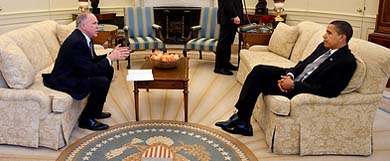 To be really useful reporting here, rather than just meaningless “color”, we’d need some context. Was the golf game’s purpose to blow off steam at an especially tense time? Did Obama not think it important enough for him to be constantly present in the hours leading up to the raid? Is this typical of his schedule when huge things are happening? We desperately need a more realistic sense of what presidents do, how much they’re really in charge, or, instead, figureheads for unnamed individuals who make most of the critical decisions.
To be really useful reporting here, rather than just meaningless “color”, we’d need some context. Was the golf game’s purpose to blow off steam at an especially tense time? Did Obama not think it important enough for him to be constantly present in the hours leading up to the raid? Is this typical of his schedule when huge things are happening? We desperately need a more realistic sense of what presidents do, how much they’re really in charge, or, instead, figureheads for unnamed individuals who make most of the critical decisions.
Here’s something just as strange: we are told the President took a commanding role in determining key operational tactics, but then didn’t seem interested in important details, after the fact.
Forty-five minutes after the Black Hawks departed, four MH-47 Chinooks launched from the same runway in Jalalabad. Two of them flew to the border, staying on the Afghan side; the other two proceeded into Pakistan. Deploying four Chinooks was a last-minute decision made after President Barack Obama said he wanted to feel assured that the Americans could “fight their way out of Pakistan.”
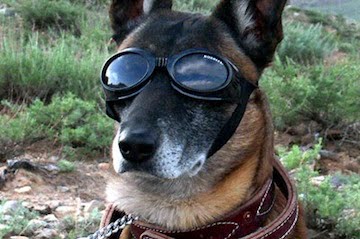 Now, consider the following climactic New Yorker account of Obama meeting with the squadron commander after it’s all over, with bin Laden dead and the troops home and safe. Schmidle decides to call the commander “James…the names of all the covert operators mentioned in this story have been changed.” The anecdote will feature a canine, one who, in true furry dog story fashion, had already been introduced early in the New Yorker piece, as “Cairo” (it’s not clear whether the dog’s name, too, was changed):
Now, consider the following climactic New Yorker account of Obama meeting with the squadron commander after it’s all over, with bin Laden dead and the troops home and safe. Schmidle decides to call the commander “James…the names of all the covert operators mentioned in this story have been changed.” The anecdote will feature a canine, one who, in true furry dog story fashion, had already been introduced early in the New Yorker piece, as “Cairo” (it’s not clear whether the dog’s name, too, was changed):
As James talked about the raid, he mentioned Cairo’s role. “There was a dog?” Obama interrupted. James nodded and said that Cairo was in an adjoining room, muzzled, at the request of the Secret Service.
“I want to meet that dog,” Obama said.
“If you want to meet the dog, Mr. President, I advise you to bring treats,” James joked. Obama went over to pet Cairo, but the dog’s muzzle was left on.
Here’s the ending:
Before the President returned to Washington, he posed for photographs with each team member and spoke with many of them, but he left one thing unsaid. He never asked who fired the kill shot, and the SEALs never volunteered to tell him.
Why did the president not want to ask for specifics on the most important parts of the operation—but seemed so interested in a dog that participated? While it is certainly plausible that this happened, we should be wary of one of the oldest p.r. tricks around—get people cooing over an animal, while the real action is elsewhere.
Certainly, Obama’s reaction differs dramatically from that of other previous presidents who always demanded detailed briefings and would have stayed on top of it all throughout—including fellow Democrats JFK, Carter and Clinton. At minimum, it shows a degree of caution or ceremony based upon a desire not to know too much—or an understanding that he may not ask. Does anyone doubt that Bill Clinton would have been on watch 24/7 during this operation, parsing legal, political and operational details throughout, and would have demanded to know who felled America’s most wanted?
Summing up about the reliability of this account, which is now likely to become required reading for every student in America, long into the future:
- It is based on reporting by a man who fails to disclose that he never spoke to the people who conducted the raid, or that his father has a long background himself running such operations (this even suggests the possibility that Nicholas Schmidle’s own father could have been one of those “unnamed sources.”)
- It seems to have depended heavily on trusting second-hand accounts by people with a poor track record for accurate summations, and an incentive to spin.
- The alleged decisions on killing bin Laden and disposing of his body lack credibility.
- The DNA evidence that the SEALs actually got their man is questionable.
- Though certain members of Congress say they have seen photos of the body (or, to be precise, a body), the rest of us have not seen anything.
- Promised photos of the ceremonial dumping of the body at sea have not materialized.
- The eyewitnesses from the house—including the surviving wives—have disappeared without comment.
We weren’t allowed to hear from the raid participants. And on August 6, seventeen Navy SEALs died when their helicopter was shot down in Afghanistan. We’re told that fifteen of them came, amazingly, from the same SEAL Team 6 that carried out the Abbottabad raid—but that none of the dead were present for the raid. We do get to hear the stories of those men, and their names.
Of course, if any of those men had been in the Abbottabad raid—or knew anything about it of broad public interest, we’d be none the wiser—because, the only “reliable sources” still available (and featured by the New Yorker) are military and intelligence professionals, coming out of a long tradition of cover-ups and fabrications.
Meanwhile, we have this president, this one who according to the magazine article didn’t ask about the core issues—why this man was killed, who killed him, under whose orders, what would be done with the body.
Well, he may not want answers. But we ought to want them. Otherwise, it’s all just a game.
We know—from feedback—that readers like you love these stories.
Want to help us expand quickly and do more of them, on more topics?
Please click here to donate and support our work.
Remember—it’s tax deductible. And it packs a punch.
